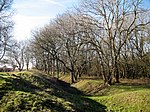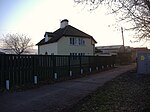Clapton Moor

Clapton Moor is a 40-hectare (99-acre) Avon Wildlife Trust nature reserve and part of the Gordano Valley, Clapton Moor, Middle Bridge and rhynes Site of Nature Conservation Interest in Somerset, England.Clapton Moor is located in the Gordano Valley region of North Somerset. Precisely, north of Clevedon lane, in between the villages of Weston-in-Gordano and Clapton-in-Gordano. The nature reserve lies within the borders of the Clapton-in-Gordano civil parish.Access to the reserve is restricted for non-permit holders, but a public footpath passes through the reserve from Clapton Drove to Clevedon lane. There is a path which leads to a bird hide in the south of the reserve, and a bridge across a large rhyne near the eastern boundary.
Excerpt from the Wikipedia article Clapton Moor (License: CC BY-SA 3.0, Authors, Images).Clapton Moor
M5,
Geographical coordinates (GPS) Address Website Nearby Places Show on map
Geographical coordinates (GPS)
| Latitude | Longitude |
|---|---|
| N 51.4575 ° | E -2.78 ° |
Address
Clapton Moor Nature Reserve
M5
BS20 7RQ
England, United Kingdom
Open on Google Maps










